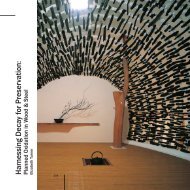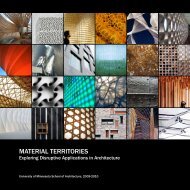Construction History: Between Technological and Cultural History
Construction History: Between Technological and Cultural History
Construction History: Between Technological and Cultural History
You also want an ePaper? Increase the reach of your titles
YUMPU automatically turns print PDFs into web optimized ePapers that Google loves.
Antoine Picon<strong>Construction</strong> history1.7J. P. Jungmann,Dyodon,anexperimentalpneumaticdwelling. EcoleNationaleSuperieure desBeaux-Arts, 1967.J.8rlelnrich von Kleist,dla9rarn of a~ul t . Letter toWJlheirnlne vonzen9e, 18rJOvember 1800.fa~ade 2ECHfl L E 1{50domes were to be found both in Buckminster Fuller's commissions for the military<strong>and</strong> in alternative communities like Drop City. Similarly, the researches oninflatable structures circulated from the military-industrial complex to 1968counterculture 14 (Figure 1. 7).However, these links leave aside intellectual <strong>and</strong> cognitive dimensions thathad been more systematically invoked by nineteenth-century authors like Violletle-Duc.For him, Gothic was once more synonymous with a mode of reasoning,which was in its turn plugged into the broader culture of the Middle Ages. ErwinPanovsky's famous 1951 essay Gothic Architecture <strong>and</strong> Scholasticism wasprobably one of the last expressions of this kind of approach . 15 Panovsky's mainargument- the analogy between the hierarchy of Gothic architecture <strong>and</strong> thestructure of scholastic reasoning- was of course disputable. Such an ambitiousattempt at relating a construction mode as extensive <strong>and</strong> varied as Gothic to theintellectual world is always risky. Despite this risk <strong>and</strong> the confusion it can leadto, one cannot but be struck by the fact that construction represents an endlesssource of metaphors, from the vault that inspired Classical authors like CharlesPerrault or Heinrich von Kleist 16 (Figure 1.8) to the cantilever exalted in variouscontemporary writings. These metaphors indicate that its relation to culture is farmore profound than one might suppose at first.On one side, construction points towards abstract <strong>and</strong> general thought. Even ifhis analysis of Gothic was flawed by excessive generalization, Panovsky wasprobably right in supposing that at some points in history, there are connectionsbetween tectonic choices <strong>and</strong> intellectual preferences. At a much more I i mitedscale than Panovsky, I have tried in various articles to show how the theme of theprimitive hut <strong>and</strong> the constructive pattern of trabeation have to do with the trendtowards analytical reasoning that characterizes late eighteenth-century FranceYThe quest for structural clarity that explains the preference given to a clear-cutdistinction between vertical <strong>and</strong> horizontal members - in other words, the preferencegiven to the system of the column <strong>and</strong> entablature instead of the arch invarious eighteenth-century French churches, the so-called freest<strong>and</strong>ing columnchurches- has to do with a contemporary tendency to reason using systematicdecomposition of complex objects into well-distinguished elements.In a similar vein, contemporary structural creativity is clearly related to anevolution in the way we reason about nature. It reflected the dynamic interpretationof natural structures to be found in the scientific work of Haeckel or DarcyThompson at the turn of the twentieth century; hence the enduring success ofThompson's book On the Growth of Form among architects <strong>and</strong> engineers. Later,from the 1950s on, it was to be marked by the notion of pattern that was developedin connection with cybernetics <strong>and</strong> system theory, a notion mobilized in the domainof the arts <strong>and</strong> design by a theorist like Gyorgy Kepes. 18 All these connectionsrepresent a first side of what constructive metaphors are about.But also, constructive metaphors have to do with a much more intuitive levelat which our underst<strong>and</strong>ing of the natural constraints is dependent on our historicallydetermined perception of the body. In order to clarify what I mean by thisdependence on the perception of the body, I would like to start from a quotationfrom the famous Spanish engineer Eduardo Torroja.In his 1957 book The Reason of Structural Types, Torroja wrote that "Vainwould be the enterprise of somebody who would propose himself to design astructure without having understood to the backbone the mechanical principles ofinner equilibrium." 19 Being an engineer, he saw those principles <strong>and</strong> their interiorizationas something that was independent from history. I would like tochallenge that position. For in the underst<strong>and</strong>ing of the backbone of the mechanicalprinciples of inner equilibrium we are necessarily indebted to the way we23






